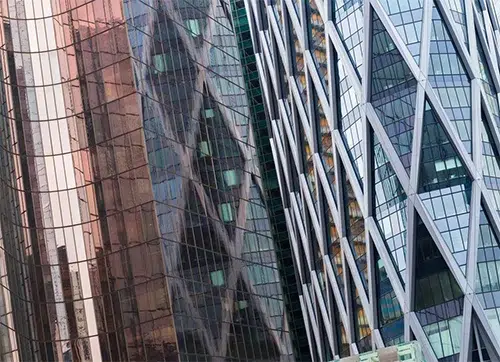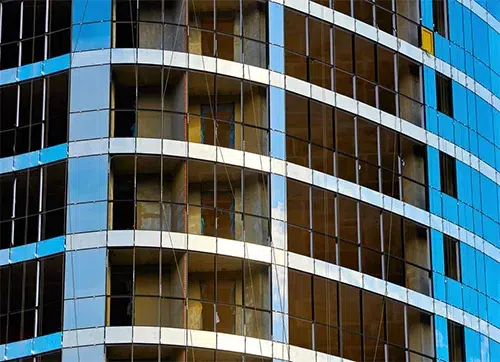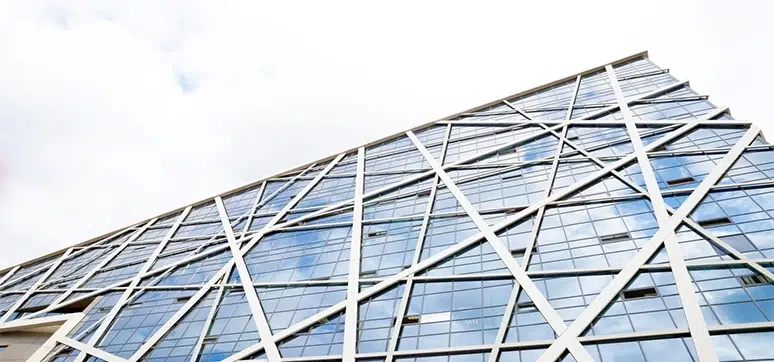Today’s high-rise buildings are shedding their static skins and embracing a new generation of intelligent systems that redefine comfort, performance, and environmental responsibility. This in-depth analysis delves into the world’s most widely installed cutting-edge façade solutions, exploring their general and specific design parameters, performance characteristics, and the materials shaping this exciting evolution. The future of high-rise buildings is being reshaped by intelligent façades, a new generation of cladding and glazing systems that go far beyond aesthetics. These dynamic systems integrate cutting-edge technologies to optimise comfort, performance, and environmental impact, setting a new standard for sustainable and responsive architecture.
General Parameters and Specific Considerations for Façade Design
- Sustainability: Minimising environmental impact through energy efficiency, resource conservation, and responsible material selection.
- Comfort: Optimising thermal and acoustic insulation, daylighting, and indoor air quality for occupant well-being.
- Thermal: Maintaining comfortable indoor temperatures through passive and active solar control, natural ventilation, and efficient insulation.
- Visual: Providing optimal daylighting while minimising glare and discomfort.
- Acoustic: Controlling noise pollution from both inside and outside the building.
- Performance: Enhancing structural integrity, weather resistance, and fire safety.
- Energy Efficiency: Reducing energy consumption for heating, cooling, and lighting through optimised design and material selection.
- Durability and Maintenance: Ensuring long lifespan and minimal maintenance requirements.
- Safety: Meeting fire, wind, and seismic resistance standards.
- Aesthetics: Integrating seamlessly with the architectural design while offering visual appeal and flexibility.
- Climate and Context: The façade’s design must respond to the specific climatic conditions and surrounding environment. Factors like solar radiation, wind patterns, and temperature fluctuations need to be considered to optimise thermal comfort and energy efficiency.
- Sustainability: Utilising recycled and recyclable materials, minimising embodied energy, and contributing to positive environmental impact.
- Air Quality: Filtering pollutants and improving indoor air quality.
- Urban Heat Island Mitigation: Reducing the urban heat island effect through shading and reflective surfaces.
- Building Use and Occupancy: The façade’s functionality should cater to the specific needs of the building occupants. For example, office buildings might prioritise daylighting and glare control, while residential buildings might focus on thermal insulation and privacy.
- Material Selection: Material choice plays a crucial role in façade performance. High-performance, lightweight, and durable materials like advanced glazing, photovoltaic panels, and kinetic elements are increasingly being favoured.
- Structural Integrity: The façade must be structurally sound to withstand wind loads, seismic activity, and other external forces. Integration with the building’s structural system is crucial for seamless performance.
- Regulations and Codes: Building codes and local regulations regarding energy efficiency, fire safety, and sustainability must be adhered to during façade design and installation.
Specific Parameters for Different Façade Types
 Cladding and Glazing Systems: Material selection: High-performance glass with coatings for thermal insulation, solar control, and self-cleaning properties. Lightweight and durable metals like aluminium and titanium for structural support. Ventilation: Integrated natural ventilation systems for improved air circulation and reduced energy consumption. Design flexibility: Modular systems allow for customisation and adaptation to diverse building shapes and orientations. Orientation: Optimising solar exposure for daylighting and heat gain control. Shading: Employing fixed or adjustable shading devices to manage sunlight and glare. Ventilation: Integrating natural ventilation strategies for improved air quality and thermal comfort. Material Selection: Choosing materials with high thermal performance, durability, and aesthetics.
Cladding and Glazing Systems: Material selection: High-performance glass with coatings for thermal insulation, solar control, and self-cleaning properties. Lightweight and durable metals like aluminium and titanium for structural support. Ventilation: Integrated natural ventilation systems for improved air circulation and reduced energy consumption. Design flexibility: Modular systems allow for customisation and adaptation to diverse building shapes and orientations. Orientation: Optimising solar exposure for daylighting and heat gain control. Shading: Employing fixed or adjustable shading devices to manage sunlight and glare. Ventilation: Integrating natural ventilation strategies for improved air quality and thermal comfort. Material Selection: Choosing materials with high thermal performance, durability, and aesthetics.- Dynamic Façades: Kinetic elements: Louvers, fins, or panels that adjust automatically or manually to regulate sunlight, temperature, and ventilation. Integrated sensors and actuators: Real-time monitoring of environmental conditions and responsive adjustments to the façade’s behaviour. Building integration: Seamless coordination with HVAC systems for optimised energy efficiency and occupant comfort.
Façade Performance: A Holistic Approach – Passive and Active Strategies
Passive Strategies:
- Double-skin façades: Creating a ventilated cavity between two layers of glazing for improved insulation and solar control.
- Green façades: Integrating living plants on the façade for natural cooling, insulation, and air purification.
- High-performance glazing: Utilising coatings and films to control solar heat gain and light transmission.
Active Strategies:
- Photovoltaic (PV) panels: Integrating solar cells into the façade to generate renewable energy.
- Electrochromic glass: Adjusting the tint of the glass electronically to control light and heat.
- Automated louvers: Dynamically adjusting louvers to optimise solar control and ventilation.
New generation façades go beyond traditional passive strategies like insulation and shading. They actively manage factors like:
- Passive Ventilation: Double-skin façades and operable louvers can promote natural ventilation, reducing reliance on mechanical systems and energy consumption.
- Active Ventilation: Integrated sensors and actuators can control ventilation systems based on real-time data, optimising indoor air quality, and thermal comfort.
- Daylighting and Glare Control: Electrochromic glazing and louver systems can adjust to optimise daylighting while minimising glare, improving occupant well-being, and reducing lighting energy use.
Material Innovation: Efficiency, Economy, and Aesthetics – Efficient, Economical, and Attractive Façade Materials
- High-performance glass: Low-emissivity (Low-E) glass, electrochromic glass, and vacuum-insulated glass offer excellent thermal performance and aesthetics.
- Metal cladding: Aluminium, steel, and titanium offer durability, weather resistance, and recyclability.
- Composite materials: Combining different materials like metal and wood can achieve unique aesthetics and performance characteristics.
- Bio-based materials: Bamboo, cork, and other sustainable materials offer eco-friendly options with good insulation properties.
The material landscape for façades is rapidly evolving, offering exciting possibilities:
- Photovoltaic Glazing: Integrated solar panels in the façade generate clean energy, contributing to the building’s energy independence and sustainability.
- Dichroic Glazing: This selective glazing filters specific wavelengths of light, allowing for enhanced thermal insulation and daylighting control.
- Intelligent Glazing: Electrochromic and thermochromic glazing dynamically adjust their tint in response to environmental conditions, providing optimal comfort and reducing energy consumption.
- Kinetic Façades: Moving louvers and panels adapt to changing sun angles and wind patterns, optimising solar heat gain and ventilation.
- Bio-inspired Materials: Self-cleaning façades with lotus effect surfaces and self-healing concrete are being explored for improved performance and reduced maintenance.
- Photochromic glass: Adapts its tint in response to sunlight intensity, reducing glare and heat gain while maintaining transparency.
- Electrochromic glass: Switches between clear and opaque states electronically, offering privacy control and solar heat gain management.
- Bio-inspired materials: Self-cleaning surfaces that mimic lotus leaves, and photovoltaic panels integrated into the façade for energy generation.
- Lightweight composites: High-strength, low-weight materials like carbon fiber composites for improved structural performance and reduced energy consumption.
Beyond Static Elements: Responsive and Communicative Façades

New generation façades are transforming from static elements into dynamic interfaces:
- Information Sensitivity: Sensors gather data on temperature, light, and air quality, informing adjustments to the façade’s behaviour. Sensors embedded in the façade collect data on environmental conditions, occupancy patterns, and energy use, informing real-time adjustments for optimal performance.
- Communication & Interaction: Façades can display information, project images, or even generate electricity through integrated photovoltaic panels. Façades can display information or even act as interactive interfaces, engaging with occupants and the surrounding environment.
- Self-Cleaning Façades: Nano-coatings and specialised materials repel dirt and dust, reducing maintenance needs and improving air quality.
- Environmentally Dynamic Façades: Responsive to changing weather conditions and occupant needs, optimising comfort and energy efficiency. Façades can adapt to changing environmental conditions, such as adjusting ventilation rates based on air quality or providing shading during heat waves.
New Generation Façades: Pushing the Boundaries
Beyond the focus on comfort, performance, and environmental parameters, the next generation of façades is venturing into exciting new territories:
- Self-cleaning: Nano-coatings repel dirt and grime, reducing maintenance requirements.
- Environmentally dynamic: Façades adapt to changing weather conditions through responsive materials and systems.
- Information-sensitive and communicating: Sensors and actuators collect and respond to data from the environment, optimising performance and interacting with occupants.
- Transparent yet photochromic: Glass that changes tint based on light conditions, providing both daylighting and glare control.
- Lightweight yet strong: Advanced materials offer high strength-to-weight ratios, reducing structural loads.
- Safe without additional processing: Inherently safe materials eliminate the need for additional safety measures.
- Energy generation: Integrated PV panels and other renewable energy technologies power the building and beyond.
Fully Responsive Parametric Façades
Parametric façades use algorithms to design and optimize their form and function based on specific parameters. This allows for:
- Sustainability: Minimizing material usage and energy consumption through optimised design.
- Power generation: Tailoring the façade to maximise solar energy capture and conversion.
- Vertical farming: Integrating hydroponic systems into the façade for urban food production.
Challenges and the Future of Façade Technology
- Balancing cost with performance remains a key challenge. However, advancements in material science and automation are driving down costs and making these intelligent systems increasingly accessible. As technology evolves, we can expect:
- Fully integrated responsive façades: Seamlessly adapting to real-time environmental conditions and occupant needs.
- Biomimetic façades: Façades mimicking natural systems for enhanced performance and sustainability.
- Hyper-connected façades: Integrating with smart building technologies for a truly holistic building experience.
- Cost-to-Performance Balance: Balancing the upfront cost of advanced technologies with their long-term performance and energy savings is crucial for wider adoption.
- Integration and Complexity: Seamless integration of diverse technologies and sensor networks into the façade system requires careful planning and execution.
- Standardisation & Regulations: Establishing clear standards and regulations for safety, performance, and data privacy associated with smart façades is crucial. Despite these challenges, the future of façade technology is bright. As research and development efforts continue, we can expect even more innovative and intelligent façades that blur the lines between building skin and living organisms, responding in real-time to their surroundings and creating truly sustainable and responsive high-rise environments.
The Living Skin of Buildings
The vision of a façade as a living skin, responding and adapting to its surroundings, is no longer science fiction. These intelligent systems are poised to revolutionise the way we design, build, and experience our high-rise environments. From optimising comfort and energy efficiency to fostering a connection with the natural world, the future of façades promises a more sustainable, responsive, and ultimately, human-centric built environment.
Here are some additional insights and resources you might find helpful:
- Case Studies: Explore real-world examples of high-performance façades in action, such as the Al Bahr Towers in Abu Dhabi or the 1 Bligh Street building in Sydney.
- Research and Development: Stay updated on the latest advancements in façade technologies through organisations like the Council on Tall Buildings and Urban Habitat (CTBUH) and the International Passive and Low Energy Architecture (IPLEA) conference.
- Visualisation Tools: Utilise software tools like IES VE and Ecotect New Generation Façades: IES Virtual Environment (IESVE) and Ecotect New Generation Façades are software tools that can help architects, engineers, and designers create energy-efficient and environmentally sustainable buildings. Ecotect is a building performance simulation software that can calculate a building’s energy consumption by simulating its context within the environment. It is designed to help architects, engineers, and designers create buildings that are not just aesthetically pleasing but also highly energy-efficient and environmentally sustainable.
Visualisation Tools ESVE and Ecotect are a suite of applications for building performance analysis. It can be used to:
- Test different options
- Identify passive solutions
- Compare low-carbon and renewable technologies
- Draw conclusions on energy use, CO2 emissions, and occupant comfort
- Model, predict, and verify performance throughout a building’s life cycle
- Evaluate architectural designs holistically
- Consider outcomes for enhanced daylighting status, occupant thermal comfort, natural ventilation, and reduced carbon emissions














